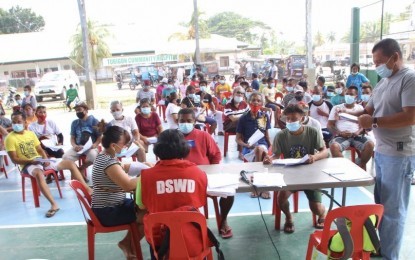
SAP RECIPIENTS. The government distributes cash aid to poor families affected by the coronavirus disease 2019 (Covid-19) pandemic through the social amelioration program (SAP) in this undated photo. Malacañang on Tuesday (Dec. 15, 2020) said it is hoping that fewer Filipinos would feel that they are poor once a vaccine for Covid-19 is available. (File photo)
MANILA – Malacañang is hopeful that fewer Filipinos would feel that they are poor once a vaccine for coronavirus disease 2019 (Covid-19) is available.
Presidential Spokesperson Harry Roque said the Palace is saddened by results of a Social Weather Stations (SWS) survey which showed that nearly half of Filipino families consider themselves “poor”.
The SWS survey, conducted from Nov. 21-25 by face-to-face interviews, found 48 percent of families rating themselves as “poor”, 36 percent feeling “borderline poor”, and only 16 percent feeling “not poor”.
“Well, nakakalungkot po talaga iyan at ‘yan ay epekto ng patuloy na lockdown natin at quarantine dahil nga po sa pandemya (That’s really sad and that’s the effect of continuous lockdowns and quarantine because of the pandemic),” Roque said in a Palace press briefing.
Roque said that once the bulk of Covid-19 vaccines is available by the third quarter of next year, more Filipinos will be able to resume their source of livelihood.
“Ang Christmas gift nalang po na maibibigay natin sa lahat ay yung pag-asa na matatapos na nga po itong pandemyang ito dahil nandiyan na ang bakuna (The Christmas gift we can give everyone is the hope that this pandemic will end soon once vaccines are available),” he said.
He also assured Filipinos that the government is doing everything to ensure that poor Filipinos will be given free vaccines while the rest will have access to affordable vaccines.
“Ginagawa natin ang lahat para maibigay ang mga bakuna sa mga Pilipino kahit na ano pang halagang ‘yan at dahil alam natin na ito lang po ang tunay na solusyon sa pandemiyang ito. Matapos po ang pandemya lahat po tayo makakabalik na po tayo sa ating mga hanapbuhay at bababa po yung kahirapan (We are doing everything to provide the vaccines to Filipinos no matter the cost and that is because we know this is the real solution to the pandemic. The pandemic will end soon and we can resume our source of livelihood and poverty will decrease),” he added.
Roque earlier said at least 20 million poorest of the poor would get free vaccine shots.
Uniformed personnel, front-liners, and those with comorbidities will also be prioritized in the government’s immunization campaign.
The SWS survey said families feeling “not poor” have declined in Balance Luzon, the Visayas, and Mindanao.
In Balance of Luzon, the self-rated “poor”, “borderline poor” and “not poor” are 42 percent, 39 percent and 20 percent, respectively, in November 2020 compared to the 47 percent, 24 percent, and 29 percent in December 2019.
The self-rated “poor”, “borderline poor” and “not poor” in the Visayas are 60 percent, 35 percent, and 6 percent, respectively, in November 2020 compared to the 67 percent, 22 percent and 12 percent in December 2019.
In Mindanao, the self-rated “poor, “borderline poor”, and “not poor” are 54 percent, 43 percent and 3 percent, respectively, in November 2020 compared to the 64 percent, 25 percent and 11 percent in December 2019.
In Metro Manila, the self-rated “poor”, “borderline poor” and “not poor” are 45 percent, 14 percent and 42 percent, respectively, in November 2020 compared to 41 percent, 17 percent and 42 percent in December 2019.
Metro Manila is the only area where families feeling “not poor” did not fall; poverty in Metro Manila worsened by three points, drawn entirely from a decline in the borderline poor.
On self-rated food poverty (SRFP), the November 2020 survey found 31 percent of families rating themselves as “food-poor, 47 percent feeling “borderline food-poor”, and 22 percent feeling “not food-poor”.
In December 2019, there were 35 percent who felt “food-poor”, 28 percent “borderline food-poor”, and 37 percent who felt “not food-poor”. From December 2019 to November 2020, the “borderline-food-poor” grew by 19 points. (PNA)
